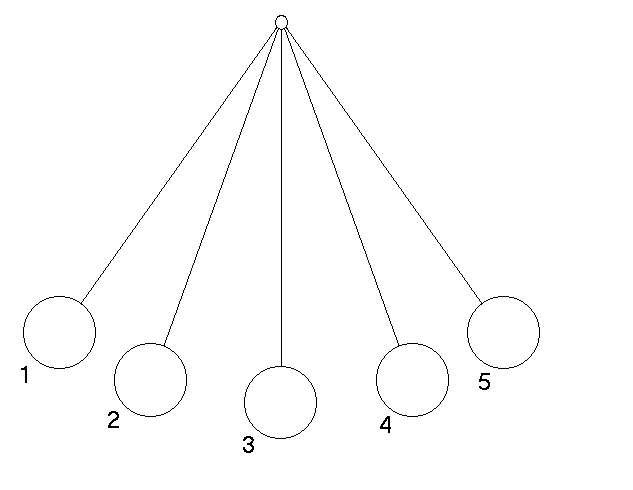for use with materialworlds pendulum simulation
© materialworlds.com 2001
In this experiment you'll investigate how the forces acting on the pendulum (at different points in its swing) change its velocity, and so make it swing.
The simulation not only shows the pendulum, but also the forces acting on it (red arrows) and its velocity (blue arrow).
Adjust the friction control to zero, so that there are just two forces acting on the pendulum bob - gravity pulling it down, and the pendulum cord pulling it in. The simulation automatically adds these two together and shows the resultant force on the pendulum bob as a red arrow with a triangle arrowhead (to find out more about adding forces, visit explorescience.com and try the vector addition activity).
1. The diagram below shows the pendulum in 5 different postions - as it swings from being stationary at position 1 though to being stationary again at position 5.
You might want to watch the simulation for a few swings before you start drawing, and try switching on the
The rewind button can always be used to set the simulation to position 1.

Give your answers to the rest of this worksheet on other sheets of paper...
2. Describe how the two forces (gravity and the tension of the pendulum cord) on the pendulum bob change (in size and direction - if there is any change) through the swing from position 1 to 5. Where are different forces at their largest and smallest?
3. Describe how the velocity of the pendulum bob changes (in speed and direction) through the swing from position 1 to 5.
At which point is the speed at its highest and lowest?
4. Starting from position 1, the pendulum bob begins to move only because of the (resultant) force on it, which accelerates it (changes its velocity) in the direction of that force. Later on exactly the same is true; the pendulum's velocity is accelerated in the direction of the force applied to it - and the velocity changes only because of the force applied to it.
In physics acceleration doesn't only mean an increase in velocity, but any change in it, including a change in direction. If the force is at right angles to the pendulum bob's velocity, it won't change its speed, but just its direction. If the force (or part of it) is in the opposite direction to the pendulum bob's velocity it will slow it down. All this comes under the broad term "acceleration". Without a force there is no acceleration, and object's velocity stays constant.
Read about "How it works" in the pendulum simulation and then in your own words explain, starting at position 1, stage by stage how and why the pendulum moves as it does.
This is just how the simulation program works - starting at one moment and working out how the forces on the pendulum will change its velocity, and therefore where it will be after a short time, then working it out again, and again - except it uses much smaller intervals between each calculation.
5. So far you've looked at just half the pendulum's swing. What happens in the other half?